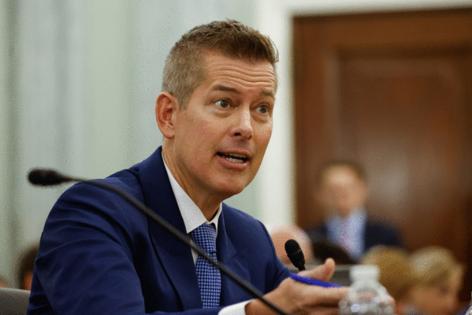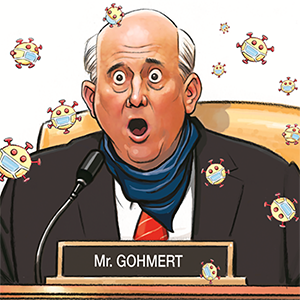Duffy to lay out transportation funding plan amid cutback push
Published in News & Features
WASHINGTON — Transportation Secretary Sean Duffy is set to return to Capitol Hill on Wednesday to pitch the Trump administration’s take on the next big transportation and infrastructure bill as GOP lawmakers mull topline infrastructure funding levels.
Duffy, who will appear at the Senate Environment and Public Works Committee, is operating under the broader Trump administration directive to end spending on green and equity programs featured in the 2021 bipartisan infrastructure law and otherwise greatly scale back federal outlays.
That law added $550 billion in new spending — such as new discretionary grant programs for transit, rail and funding for EV charging equipment — to what would’ve otherwise been a traditional surface transportation reauthorization bill. Republican lawmakers have called for a return to tradition when the current authorization expires in 2026. As as Transportation and Infrastructure Chairman Sam Graves, R-Mo., put it, that means “laying asphalt, pouring concrete, building bridges and building roads.”
Although Senate Environment and Public Works Chair Shelley Moore Capito, R-W.Va., voted in favor of the 2021 law, she has argued that the Biden administration’s implementation of certain programs was slow or, in other cases, overreaching.
“These programs require significant time and money from eligible applicants, and once a grant has been awarded, the project grant agreement was often taking more than a year to be negotiated and signed by the prior administration, which delays the benefits of each project,” she said in a hearing last month.
Capito’s goals for the bill revolve around “optimizing” federal investments in transportation, boosting efficiency and avoiding “top-down mandates” by allowing states more leeway with surface transportation funding, she said in an op-ed this month. She added that “optimizing” federal investments will include eliminating “duplicative programs that often invite regulatory overreach” and increasing funding for formula programs instead. That is likely to be popular among states that have urged lawmakers to transfer funding from discretionary grant programs to formula funding accounts, which they argue is more reliable and allows for better long-term planning.
Capito added that lawmakers will consider streamlining the current environmental review processes for transportation and infrastructure projects, which critics have said is too lengthy and bureaucratic, as well as other inefficiencies in procurement and grant requirements.
“The vision I’ve laid out is broad, but that’s intentional,” Capito said in the op-ed. “We must always be pragmatic, and work in a bipartisan fashion to develop a bill in the Senate that sets us up for a productive conversation on this reauthorization effort across both chambers of Congress.”
The topline amount the bill will provide is still up in the air. Jim Tymon, executive director of nonprofit American Association of State Highway and Transportation Officials, said in an interview that the increased funding levels provided in the 2021 infrastructure law created a new baseline, and that lawmakers need to continue to fund transportation projects at that level.
“Without this landmark legislation, states would have had to scale back projects due to the rising cost of inflation,” Tymon said. “As a bipartisan initiative, we believe that reauthorization would lead to many more success stories as state DOTs work to advance projects and build and maintain a transportation system that works for everyone.”
The Transportation Department, however, has already paused funding for certain programs. Department officials said formula funding for states hasn’t been paused, but DOT has suspended funding for some discretionary programs related to bike infrastructure, vehicle charging and other programs related to climate change and equity.
In a “report card,” the American Society of Civil Engineers rated the nation’s infrastructure an overall grade of a “C,” an improvement from a “C minus” in 2021. The report identifies federal investments from the infrastructure law and others as positively affecting infrastructure in many sectors.
The group added that, if Congress were to continue current funding levels over the next 10 years, the nation would still face a $3.7 trillion funding gap to reach a “state of good repair.” Reverting to traditional spending levels would significantly worsen that gap, it said.
“These big, significant infrastructure projects can take that long to construct if plans and permits are ready to go the second that money comes out,” Darren Olson, who chairs the organization’s Committee on America’s Infrastructure, said in a statement. “It will be critical to continue this federal leadership and investment to prevent backsliding.”
©2025 CQ-Roll Call, Inc., All Rights Reserved. Visit cqrollcall.com. Distributed by Tribune Content Agency, LLC.







Comments